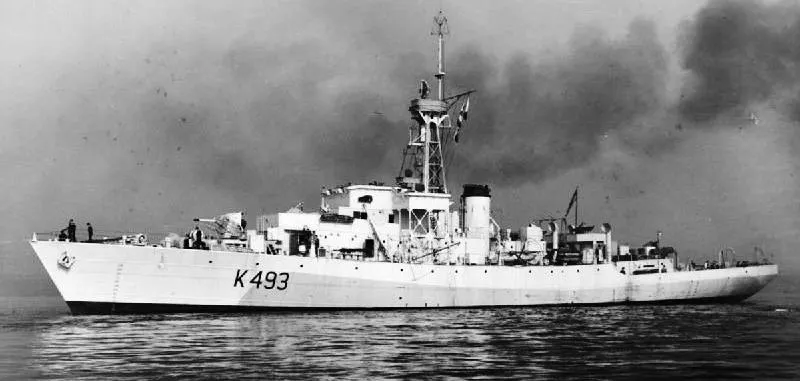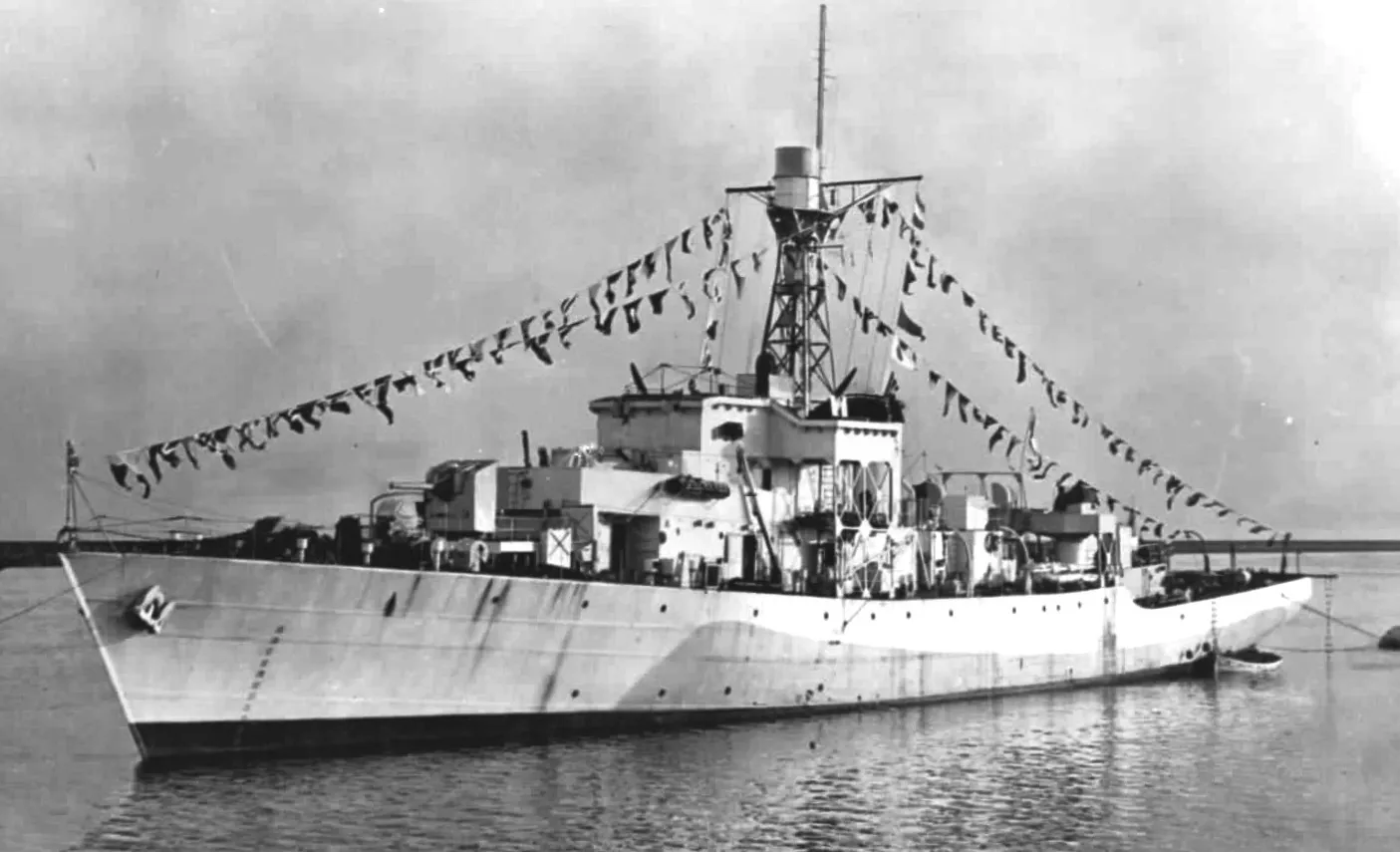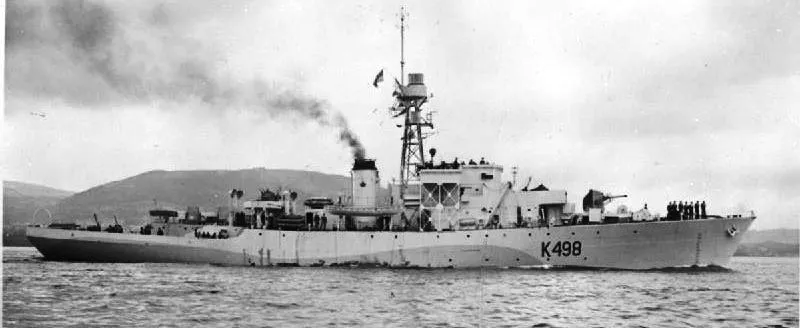Royal Canadian Navy Corvettes (Castle Class), HMCS Arnprior K494 to HMCS Tillsonburg K496
Castle Class Corvettes
HMCS Arnprior (K494) Castle-class; HMCS Bowmanville (K493) (Castle-class); HMCS Copper Cliff (K495) (Castle-class); HMCS Hespeler (K489) (Castle-class); HMCS Humberstone (K497) (Castle-class); HMCS Huntsville (K499) (Castle-class); HMCS Kincardine (K490) (Castle-class); HMCS Leaside (K492) (Castle-class); HMCS Orangeville (K491) (Castle-class); HMCS Petrolia (K498) (Castle-class); HMCS St. Thomas (K488) (Castle-class); HMCS Tillsonburg (K496) (Castle-class)
HMCS Arnprior (K494)

(Bill Perks Photo)
HMCS Arnprior (K494) alongside in St John's, NFLD with the surrendered U-190 across the jetty from her. ML Q095 in the background. Laid down as HMS Rising Castle K398, she was built by Harland & Wolff Ltd., Belfast, Ireland. After completion, she was transferred and commissioned into the RCN on 8 Jun 1944 as HMCS Arnprior K494 (renamed on the day she was commissioned). After working up at Tobermory she joined EG C-1 at Londonderry in August, leaving on 19 Aug 1944 to join her first convoy, ONM.249. HMCS Arnprior was continuously employed as an ocean escort for the balance of the war. At the beginning of Jun 1945, she left Greenock for St. John's, Newfoundland, where she underwent a two-month refit, and from September was based at Halifax, Nova Scotia. She was paid off there on 14 Mar 1946, and sold later that year to the Uruguayan Navy, which renamed her Montevideo and operated her as a training ship until 1975.

(DND Photo)
HMCS Arnprior (K494) Castle-class.
HMCS Bowmanville (K493)

(RCN Photo)
HMCS Bowmanville (K493) (Castle-class). Built by William Pickersgrill & Sons Ltd., Sunderland, UK, she was laid down and launched as HMS Nunney Castle. After completion she was as transferred to the RCN and commissioned at Sunderland, U.K. as HMCS Bowmanville K493 on 28 Sep 1944. Following workups at Tobermory, HMCS Bowmanville joined EG C-4 at Londonderry, sailing on 24 Nov 1944 to join her first convoy, ON.268. She served continuously as an ocean escort for the rest of the war. Early in Jun 1945, she left Londonderry for the last time, and was based at Halifax, Nova Scotia, until paid off on 15 Feb 1946. She was sold into mercantile service in 1947 under the Chinese flag, and first renamed Ta Shun, then Yuan Pei. In 1949 she was taken over by the Chinese Communist government, re-armed and renamed Kuang Chou.

(Library and Archives Canada Photo, MIKAN No. 3199179)
HMCS Bowmanville, RCN Castle-class Corvette, departing St. John's harbour, view from Signal Hill, 28 July 1945.


(Library and Archives Canada Photo, MIKAN No. 3199179)
HMCS Bowmanville, RCN Castle-class Corvette, departing St. John's harbour, 28 July 1945.
HMCS Copper Cliff (K495)

(William Carey Photo via Jeff Tripp)
HMCS Copper Cliff (K495) (Castle-class). Built at Blyth, UK, she was laid down as HMS Hever Castle K521. After completion she was transferred to the RCN and commissioned at Blyth, UK, on 25 Jul 1944, as HMCS Copper Cliff K495. After working up at Tobermory in August she was assigned to EG C-6 but in fact joined EG C-7 then forming at Londonderry, in Oct 1944 and was thereafter continuously employed as an ocean escort. HMCS Copper Cliff left Londonderry for her final westward crossing early in Jun 1945, and later that month sailed from Halifax for Esquimalt. There, on 21 Nov 1945, she was paid off into reserve. In 1946 she became the Chinese-flag merchant ship Ta Lung, soon afterward renamed Wan Lee, and was taken over by the Chinese Communist government in 1949.

(Jeff Tripp Photo)
Depth charge exploding astern of HMCS Copper Cliff.

(Jeff Tripp Photo)
HMCS Copper Cliff (K495) (Castle-class).

(Jeff Tripp Photo)

(Elizabeth Wagner Photo)
HMCS Copper Cliff (K495) (Castle-class).

(John Vukson Photo)
HMCS Copper Cliff (K495) (Castle-class).

(Jeff Tripp Photo)
HMCS Copper Cliff (K495) (Castle-class).

(John Vukson Photo)
HMCS Copper Cliff (K495) (Castle-class).
HMCS Hespeler (K489)

(DND Photo)
HMCS Hespeler (K489) (Castle-class). Built at Leith, Scotland, she was laid down and launched as HMS Guildford Castle K378. On completion, she was transferred to the RCN and commissioned on 28 Feb 1944 as HMCS Hespeler K489 at Leith. Following workups at Tobermory she arrived at Londonderry in April to become a member of EG C-5. HMCS Hespeler sailed on 21 Apr 1944 to meet her first convoy, ONS.233, and for the next 11 months was employed as an ocean escort. On 23 Jul 1944, she left St. John's with EG C-5 to escort the largest convoy of the war, HXS.300. She left 'Derry for the last time on 08 Mar 1945, to escort ON.289 westward, and upon arriving at Halifax began a refit, completing it at Liverpool, Nova Scotia, in Jul 1945. She then sailed for the west coast and on 15 Nov 1945 was paid off into reserve at Esquimalt. Sold in 1946 to the Union Steamship Co., Vancouver, she was converted to a coastal passenger ship, SS Chilcotin. In 1958 she became the Liberian-flag Stella Maris and in 1965, the Greek Westar. She was sold again in 1965 to become an Alaskan Cruise Liner. A few days into her voyage to Vancouver, on 28 Jan 1966, a fuel line became disconnected spraying oil into the engine room. An explosion and fire followed - the ship being declared a constructive loss. Alaskan Cruise Lines sold the hulk for scrapping at La Spezia, Italy, saving only the ship's bell.

(Library and Archives Canada Photo, MIKAN No. 3232824)
HMCS Hespeler (K489) (Castle-class), 5 May 1944.
HMCS Humberstone (K497)

(DND Photo)
HMCS Humberstone (K497) (Castle-class). Built at Glasgow, Scotland, she was laid down and launched as HMS Norham Castle. On completion she was transferred to the RCN and commissioned as HMCS Humberstone K497 at Glasgow on 06 Sep 1944. After working up at Tobermory she arrived in October at Londonderry to join EG C-8, then forming. She left 'Derry 22 Oct 1944 to join convoy ON.261 for her first Atlantic crossing and continued in service as an ocean escort for the remainder of the war. HMCS Humberstone left Londonderry 12 May 1945, for her last convoy, ONS.50, and in Jun 1945 sailed to Esquimalt, where she was paid off on 17 Nov 1945 . She was sold to Chinese owners in 1946 and converted for merchant service as Taiwei, subsequently undergoing five more name-changes before becoming the Korean South Ocean in 1954. She was broken up at Hong Kong in 1959.

(Michael Goodfellow Photo)
HMCS Humberstone (K497), St. Johns, Newfoundland.
HMCS Huntsville (K499)

(DND Photo)
HMCS Huntsville (K499) (Castle-class). Built by Ailsa Shipbuilding Co. Ltd., Troon, Scotland, she was laid down and launched as HMS Woolvesey Castle K461. On completion she was transferred to the RCN and commissioned as HMCS Huntsville on 6 Jun 1944, on the Clyde. She worked up at Stornoway early in July and joined EG C-5 at Londonderry later that month, leaving on 11 Aug 1944 for ONS.248, her first convoy. In Nov 1944 Huntsville missed a convoy while under repair in Halifax and acted as local escort to one convoy from St. John's to New York - seemingly the only ship of her class to visit there. Rejoining the Atlantic convoy cycle in Dec 1944, she left Londonderry for the last time on 16 Apr 1945, to meet ON.297. In May 1945 she commenced refit at Halifax, completed in Aug 1945, and in Sep 1945 she was placed in reserve. Paid off for disposal on 15 Feb 1946 at Halifax, and sold that year, she entered service in 1947 as SS Wellington Kent. Renamed Belle Isle II in 1951. Following a collision near Trois-Rivieres., Quebec, on 19 Aug 1960, she grounded and burned out.

(Colin Trotter Photo)
HMCS Huntsville (K499) (Castle-class).
HMCS Kincardine (K490)

(DND Photo)
HMCS Kincardine (K490) (Castle-class). Laid down and launched as HMS Tamworth Castle, she was, on completion, transferred to the RCN and commissioned at Middlesbrough on 19 June 1944 as HMCS Kincardine. After working up at Tobermory and Stornoway she arrived at Londonderry late in Aug 1944 to join EG C-2 but had to return to her builder's for repairs. Returning to Londonderry in mid-Sep 1944, she remained on local duties until 02 Oct 1944, when she left to join ON.257, her first convoy. HMCS Kincardine served as an ocean escort for the remainder of the war, leaving 'Derry for the last time at the beginning of Jun 1945. Briefly allocated to HMCS Cornwallis for training in Jul 1945, she then underwent a minor refit at Liverpool, Nova Scotia. She was placed in maintenance reserve at Halifax in Oct 1945, and then she was paid off there on 27 Feb 1946. Later that year she was sold to the French government and resold in 1947 to Moroccan interests, to be renamed Saada.
HMCS Leaside (K492)

(DND Photo)
HMCS Leaside (K492) (Castle-class). Laid down and launched as HMS Walmer Castle K460, she was transferred to the RCN and commissioned on 21 Aug 1944, at Middlesbrough as HMCS Leaside K492. Following workups at Tobermory in Sep 1944 HMCS Leaside arrived at Londonderry early in Oct 1944 to join EG C-8, then forming. She sailed on 22 Oct 1944 to meet ON.261, her first convoy, and served the rest of the war as an ocean escort. On 11 May 1945, HMCS Leaside K492, HMCS Edmundston K106 and HMCS Poundmaker K675 departed Londonderry for the last time as escort for convoy ONS.50. HMCS Leaside left St. John's in Jun 1945 for Esquimalt, where she was paid off for disposal on 16 Nov 1945. Sold in 1946 to the Union Steamship Co., Vancouver, she was converted to a coastal passenger vessel and renamed Coquitlam. In 1950 she was renamed Glacier Queen. In 1970 she stripped in anticipation of becoming a floating restaurant but the plans for the restaurant fell through and she was left as a hulk. The hulk sank in Cook Inlet, Alaska, on 8 Nov 1978, but was raised and towed to sea and scuttled in Jan 1979.

(Robert Cooke Photo)
HMCS Leaside (K492) (Castle-class) on the day of her commissioning.
HMCS Orangeville (K491)

(Bill Abercrombie Photo)
HMCS Orangeville (K491) (Castle-class). Laid down and launched as HMS Hedingham Castle, she was transferred to the RCN and commissioned at Leith on 24 Apr 1944 as HMCS Orangeville K491. After working up at Tobermory in May she joined EG C-1 at Londonderry, leaving on 04 Jun 1944 to meet ONS.239, her first convoy. She spent the remainder of the war on North Atlantic convoy duty, leaving 'Derry for the last time on 21 Apr 1945, to escort ONS.48. After refitting at Liverpool, Nova Scotia, from May to Aug 1945, HMCS Orangeville was placed in maintenance reserve at Halifax and finally paid off on 12 Apr 1946. She was sold later that year for conversion to mercantile use under the Chinese flag and renamed Ta Tung. In 1951 she was taken over the the Nationalist Chinese government, rearmed and renamed Te-An.

(RCN Photo)
HMCS Orangeville (K491) (Castle-class)
HMCS Petrolia (K498)

(DND Photo)
HMCS Petrolia (K498) (Castle-class). Laid down and launched as HMS Sherborne Castle K453, she was built by Harland & Wolff Ltd., Belfast, Ireland. She was, on completion, transferred to the RCN and commissioned on 29 Jun 1944 as HMCS Petrolia K498 (renamed the day she was commissioned), at Belfast. Following workups at Tobermory, she joined EG C-4 at Londonderry in Aug 1944, leaving on 2 Sep 1944 for her first convoy, ONS.251. An ocean escort for the rest of the war, she left Londonderry for the last time early in Jun 1945. In Aug 1945 Petrolia underwent a refit at Charlottetown and was placed in maintenance reserve at Halifax in Oct 1945. Paid off at Liverpool, Nova Scotia on 8 Mar 1946, she was sold not long afterward to a New York buyer and renamed Maid of Athens. In 1947 she was transferred to Indian registry and renamed Bharat Laxmi, serving until broken up at Bombay in 1965.
HMCS St. Thomas (K488)

(DND Photo)
HMCS St. Thomas (K488) (Castle-class). Built at Smith's Dock Co., South Bank-on-Tees, UK, she was laid down and launched as HMS Sandgate Castle. On 4 May 1944 she was transferred to the RCN and commissioned at Middlesbrough as HMCS St. Thomas K488. In Jun 1944 St. Thomas carried out workups at Tobermory, leaving later that month for Londonderry where, in Jul 1944, she became part of EG C-3. She sailed on 3 Aug 1944 to join ON.247, her first convoy, and was employed as an ocean escort for the rest of the war. On 27 Dec 1944, while escorting HX.327, north-west of the Azores, she sank U-877 in the North Atlantic with her squid mortar. She rescued 35 of the U-boats crew, while HMCS Sea Cliff rescued another 21. She left Londonderry for the last time on 11 Apr 1945, commencing refit on arrival at Halifax 30 Apr 1945. Following completion of the refit in Jul 1945 she sailed for the west coast and was paid off at Esquimalt on 22 Nov 1945. In 1946 she was sold to the Union Steamship Co., Vancouver, converted to a coastal passenger vessel, and renamed Camosun. She was renamed Chilcotin in 1958 and, later that year, Yukon Star. After several years idleness, she was broken up at Tacoma in 1974.
HMCS Tillsonburg (K496)

(Sean Cox Photo)
HMCS Tillsonburg (K496) (Castle-class). Built by Ferguson Bros. Ltd., Port Glasgow, Scotland, she was laid down and launched as HMS Pembroke Castle. On completion she was transferred to the RCN and commissioned on the Clyde on 29 Jun 1944 as HMCS Tillsonburg K496. Following working-up at Stornoway, Tillsonburg arrived at Londonderry on 19 Aug 1944, sailing a week later for St. Johns, Newfoundland, to join EG C-6, then forming. Unlike her sisters, she first escorted an eastbound convoy, HXF.308, leaving St. John's on 18 Sep 1944 to join it. An ocean escort for the balance of the war, she left Londonderry for her last crossing in mid-Jun 1945. Briefly based at St. John's, Sydney, and Halifax, she was paid off at Halifax on 15 Feb 1946, and later that year was sold to Chinese owners for mercantile service. Initially named Ta Ching, she was renamed Chiu Chin in 1947. In 1951 she was taken over by the Nationalist Chinese government, rearmed and renamed Kao-An. She was discarded in 1963.
RCN, Misc.

(Library and Archives Canada Photo, MIKAN No. 3715774)
RCN Corvette in drydock, Portsmouth, England facing HMS Victory.

